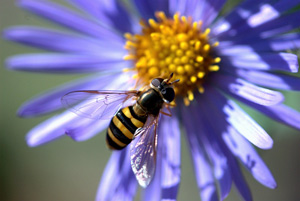In a revealing article in the Wall Street Journal, Ian Berry explains how resistance to an engineered Bt gene by corn rootworms is leading to reversals in the trend toward declining insecticide use on corn in the U.S. Resistance was first discovered by entomologist Aaron Gassman, as we reported, about two years ago.

Photo: Flickr user the_silver_angel_13
The cultivation of tens of millions of acres of corn in monoculture (corn planted year after year), or in short rotations (corn followed by soybeans), inevitably leads to resistance and dependence on large amounts of insecticides.
Even More Pesticide
But Mr. Berry substantially under-reports the amount of pesticide used now and in the past several years. He writes that corn acres treated with insecticide fell from 25 percent in 2005 to 9 percent in 2010, according to the USDA.
But these numbers greatly undercount actual pesticide use in corn. Apparently the USDA data reported by Mr Berry does not include the use of pesticides as seed treatments, and that makes a BIG difference. By many accounts, almost all corn seed is now coated with neonicotinoid insecticides. So is much of the soybean seed. Most corn seed is also treated with fungicides. Corn and soybeans are our two most widely planted crops, at about 170 million acres, so these seed treatments add up to lot of pesticide use. And most of this is a recent occurrence, increasing rapidly beginning in the 2000s.
So instead of 9 percent of corn acres being treated, as reported by the WSJ, the reality is probably closer to 95 percent.
These insecticides, now the mostly widely used in the world, are strongly implicated by the peer-reviewed science literature as causing substantial environmental harm. Here are two of the many recent studies strongly suggesting harm to bees, which along with other pollinators are responsible for the productivity of about a third of our food–mostly fruits, vegetables, and nuts–and harm to aquatic invertebrates that fish and other animals depend on for food.
These and other studies have led to a moratorium on these insecticides in the EU, at least until the issues can be sorted out. Unfortunately, US EPA is not scheduled to decide what to do until 2018, by which time harm could be much more substantial.
Unnecessary Harm
And it is not as if the use of corn seed treatments is really needed. As recently noted in the farm press, one entomologist has pointed out that recent tests have shown little if any yield benefit from corn seed treated with neonics. This also jibes with recent discussions I have had with another corn-belt entomologist. Instead, it seems that the almost ubiquitous use of these insecticides in corn may be a response to marketing by pesticide companies, and the perception by farmers that it is a “cheap” insurance policy to protect their investment in corn that is selling at near-record prices—even if it is not really needed.
We do not know exactly how much impact these seed treatments, and other uses of neonics, are having on the environment. Other factors such as loss of habitat and varroa mites are likely also playing a role in bee decline.
But data on neonicotinoids shows that levels are often high enough to cause mortality or impaired behavior in bees and other invertebrates, and that exposure is likely to occur frequently, through consumption of tainted pollen, or exposure to tainted soil or water. Harmful levels of pesticides in the environment and likely routes of exposure—these are the two parameters that add up to actual harm. And while there remain some gaps in the data, what we already know is pretty damning.
In addition, combined exposure to neonics and other pesticides, including some fungicides, can have harmful synergistic effects.
USDA needs to collect data on how much neonics are being used to treat seeds ASAP, tight budgets or not, and EPA needs to show some real urgency in addressing the issue of harm to the environment. The use of these insecticides should be suspended while we determine more accurately how much impact they are having. The cost of doing so will be small, at most. In fact, the cost would likely be nil if we were growing our food using the best principles of biology. The cost of delay, on the other hand, could be huge.
